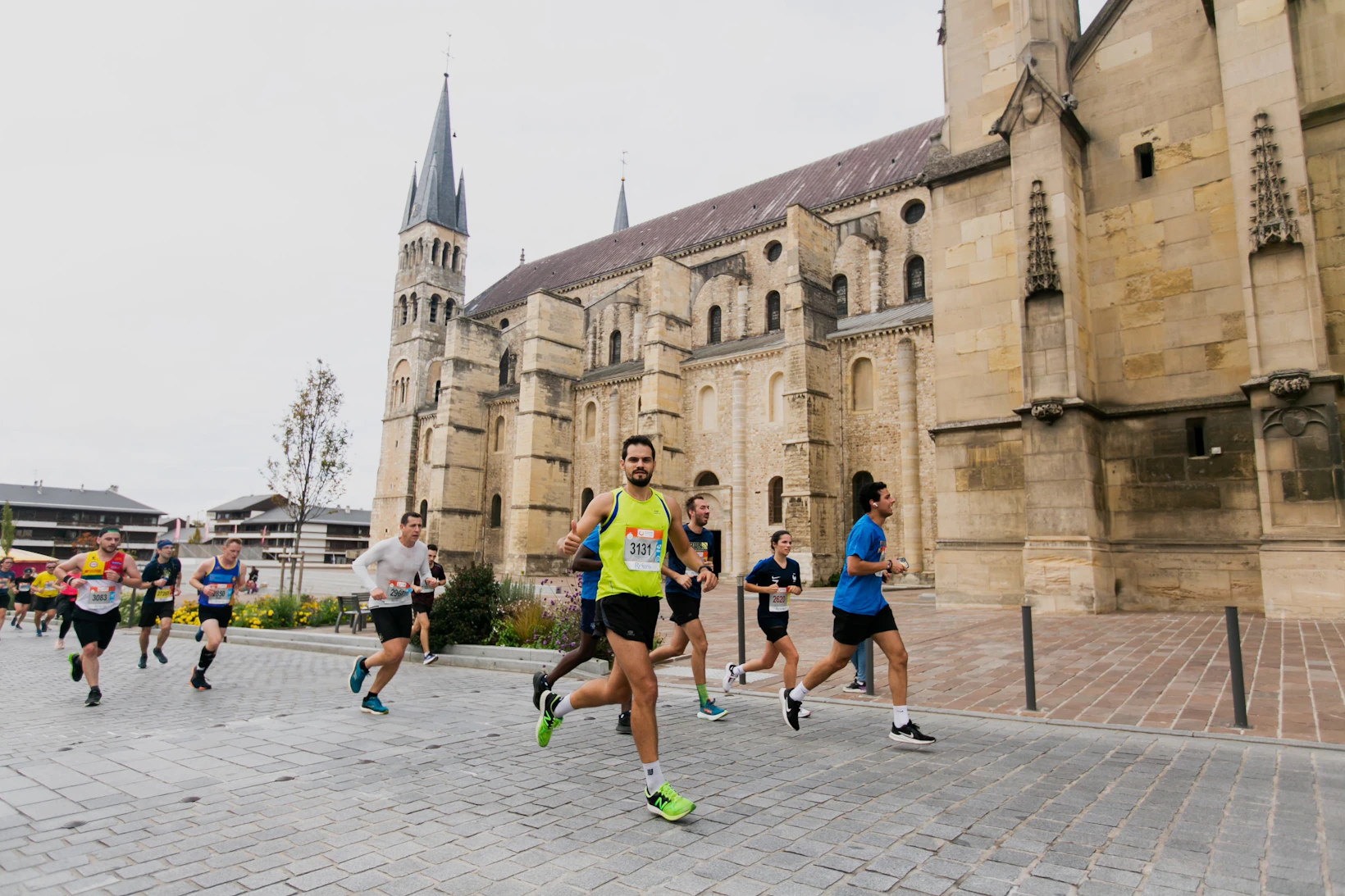The complete guide to successfully preparing for a half-marathon in 4 months

15 min read
Summary
The half-marathon, an accessible distance for all runners
What is the average time to finish a half-marathon?
What level is required to run a first half-marathon?
What training volume and frequency to prepare for a half-marathon?
The advantages of a 16-week training plan for the half-marathon distance?
Time for good progression of your mileage / your training load
Time to lay a good foundation for general development, build yourself a strong body
Time to familiarize yourself with the half pace
Key points to succeed in your half prep
Rest and listen to your body
Add muscle strengthening
Schedule a preparatory race and/or a test session
Take care of your tapering during the last ten days
Final tips for race day
How to properly prepare your nutrition plan for a half-marathon as a beginner?
How to manage your race well?

Receive advice from our passionate coaches!
Your half-marathon is scheduled in four months. You have a little over 16 weeks to prepare well. First of all, congratulations to you, because choosing a good preparation duration is already an important step towards achieving your goal. 16 weeks for your half-marathon preparation ensures ample progression, a nice variety in training, and prepares you for the big day stress-free. Here are all our tips for having the best possible preparation.

The half-marathon, an accessible distance for all runners
What is the average time to finish a half-marathon?
The average time to complete a half-marathon is around 2 hours, for all genders and ages. The range between 1h45 and 2h15 captures the majority of runners. Of course, disparities are significant depending on initial physical fitness, age, and gender. The average time for users of Campus is 1h47. You will find all the details in this article.
What level is required to run a first half-marathon?
Do not underestimate the preparation for a half-marathon as running 21.1 kilometers non-stop is a significant accomplishment. However, rest assured, the half is much more approachable than a marathon. In fact, it is the most run distance in the hexagon. Even if you're new to running, it is possible to accomplish this challenge. The only condition is to take your time and be consistent and committed in your preparation. Ideally, you'll incorporate a preparatory 10 km race during your half-marathon prep. It's a great way to reassure yourself, especially if the half-marathon is your very first official race.
What training volume and frequency to prepare for a half-marathon?
Regularity in half marathon preparation is the primary key to progress in running. According to us, the minimum is to run three times a week to notice significant progress in the long term; with two weekly sessions, stagnation occurs quickly. After becoming comfortable with three sessions, you can consider increasing if you wish. Starting with four weekly sessions helps restart progress and accelerate the process.
Regular sequencing of workouts, even of short duration, is the perfect compromise between consistency and stress intensity. This allows optimal progress by increasing stress assimilation. Doing just one intense session creates a great stress, which is good, but it won't be well-assimilated (not to mention the risk of injury). That's why it's always better to complete three or four sessions per week than one or two long runs.
Training volume is another important pillar. It is even one of the primary predictors of performance, especially when distances lengthen. A good volume will help you both develop your cardio and naturally strengthen your body (muscles, tendons, joints). We usually say that volume unlocks speed. In fact, accumulating "slow" kilometers naturally improves your recovery capacities and helps you better handle intense workouts. That's why we place so much emphasis on base endurance. Easy jogs should account for 70% to 80% of your total training volume. In terms of volume, if your only goal is to cross the finish line, we recommend running at least the half-marathon distance in your week, at a minimum of 21 kilometers weekly.
The advantages of a 16-week training plan for the half-marathon distance?
There are many benefits to following a half-marathon training plan over 16 weeks.
Time for good progression of your mileage / your training load
Injury is the runner's first enemy. It is often linked to too great a variation in training load (mileage x intensity). That's why we emphasize the concept of progression. You will have less chance of being injured if you very gradually increase your weekly volume. A long-term plan goes hand in hand with good progression, yet another asset for a 16-week half-marathon preparation.
Time to lay a good foundation for general development, build yourself a strong body
We can break down a preparation into three great phases. First a general development phase in which you'll develop your runner's toolkit harmoniously. Then a phase of specific development to your half-marathon pace. Finally, in a last phase of tapering or sharpening.
The first phase is very important. It forms the basis of your preparation. The more solid the foundations, the more you'll maximize your potential. It includes a good base of runs at base endurance (between 65% and 75% of your Maximum Heart Rate), interval training around your 60' Threshold and 30' Threshold (between 85% and 90% of your Max HR), intervals, and long runs that can reach up to 1h30. Indeed, the 16-week plan offers the possibility of progressively elongating long runs contrary to shorter plans.
And since the principle of this phase is variety, we'll add MAS development sessions or even sprints. This diversity is even more true for a beginner runner who does not yet have a specific profile.
In a 16-week preparation, you can allocate two blocks of four weeks—three weeks of development and one week of assimilation—to general development. This greatly increases your chances of succeeding in your half-marathon.
The coach's opinion:
The general development phase is also the right time to adapt to the runner's needs. For an expert, focusing on weaknesses far from the goal. And for a beginner, simply adding variety to diversify stresses and adaptations before the specific phase.
Time to familiarize yourself with the half pace
After the first eight weeks dedicated to general development, it's time to tame the half pace. Again, gradual progression is essential. The first sessions are easy, and over the weeks, we will lengthen the duration of intervals run at half-marathon pace. The more you multiply these specific sessions, the more your body and mind will integrate this pace, and the more you will develop your running economy at the half pace.
Coach's insight:
When you start running, this phase is not the most important, as in eight weeks, you tend to make significant progress. Indeed, the pace to work at the beginning of the cycle may become faster by several tenths of a second after 8 weeks. So for a beginner, the key is to stress your body and build confidence in the paces. However, it gains more and more physiological importance as the profile becomes expert.

Key points to succeed in your half prep
Rest and listen to your body
To progress in running, you must train, but that's not enough. You also need to know how to rest to assimilate the sessions properly. First advice: don't try to exceed the training plan. Your plan follows a logic of load progression. If you add sessions, you'll break this balance and risk injury. Respect the assimilation weeks, lighter in volume and intensity. Take care of your body outside workouts (sleep, nutrition, hydration, mobility routines, massage...) and be attentive to your sensations. For example, if you feel very tired/stressed after a workday, it's better to skip the intense workout that was planned in your schedule.
Add muscle strengthening
The benefits of strength & conditioning in running are no longer needed to demonstrate. One of the benefits of having stronger muscles is delaying muscle fatigue besides the simple overall health gain. However, muscular fatigue is a limiting factor for many runners in half-marathons, much more than cardio-respiratory aspects. The total training volume, long runs, or even hilly terrain running contribute to naturally strengthening your body. However, muscle strengthening is a significant addition, both to delay fatigue, to preserve your tendons and joints, correct imbalances, and thus reduce the risk of injury. You can practice it at home, with body weight or with minimal equipment (dumbbells, bands, kettlebells).
Coach's point of view:
Even a small body weight routine at home is already a significant addition that's worthwhile.
Schedule a preparatory race and/or a test session
A 16-week prep gives ample time to participate in one or more preparatory races. It is quite possible to run a 10k during the general development phase. However, the real preparatory race will occur during the last block. Think of this race as a "super session" that replaces your half pace session and long run of the week.
Two or three weeks before the half-marathon, you can sign up for a 10k. The key word is management. After a good warm-up, run the first 6 kilometers at your half-marathon pace (90-92% of your Maximum Heart Rate), then the last 4 kilometers based on how you feel. Allow two or three days of recovery after the race, without intense sessions.
Be careful during this race, the primary goal is to finish strong and not generate unnecessary fatigue. If you finish the 10k in exhaustion and redlining 3 weeks before your main race, you're shooting yourself in the foot.
Otherwise, we advise you to have a test session about ten days before your half-marathon. You're about to enter the tapering period. It is the right time to perform this last intense session, whose main goal is to validate your half-marathon pace. It consists of several intervals of 2,000 to 4,000 meters, with short recovery times, for a total distance of 8 to 10 kilometers. The workout 3 x 3,000 meters with 1'30 recoveries is an excellent compromise. Make sure to stay within the proper half effort zone, between 85% and 90% of your Maximum Heart Rate. Do not exceed 92% of Max HR during the last interval. A little bonus: remember to consume carbs during this session. This will help you recover properly.
Take care of your tapering during the last ten days
You are 10 days away from your half-marathon. The work is done. There are no longer any intense workouts in your training plan. That's normal because it would generate too much fatigue, and you wouldn't have time to assimilate it before the race. On the contrary, the training volume gradually eases—about 75% of the usual volume by week two and 50% by week one. Logically, your fatigue diminishes, and your fitness level increases. You might feel strange sensations during the tapering period, almost a lack. It's perfectly normal. Everything is done to help you reach your shape peak on race day!
Final tips for race day
How to properly prepare your nutrition plan for a half-marathon as a beginner?
The fastest runners don't have to worry about fueling during the half-marathon. Up to 1h to 1h15 of effort, their glycogen stores are enough to provide the necessary energy. However, for the majority of the field, energy autonomy is insufficient to last 1h30, 2h, or more. Carbohydrate intake during the race is essential. Sports drink, gels, fruit purees, you must test during training which product(s) suit you best and do not cause digestive issues. Take advantage of long runs and your half-marathon pace sessions to try these products under race conditions.
Some advice:
Train yourself to consume at least 40 to 50 grams of carbohydrates per hour. This is equivalent to one gel and 500 mL of isotonic drink. If you consume gels, always drink some water. We recommend carrying at least a small soft flask or a bottle on you. Next, it's better to drink small sips regularly than a large quantity. Most importantly: Do not try anything new on race day. Avoid consuming products provided at aid stations that you haven't tried beforehand.

plan semi marathon
How to manage your race well?
If you want to have the best experience possible and/or beat your Personal Record, managing your effort is paramount. The number one rule is immutable: don't start too fast. With the excitement of the start, it's very tempting to let loose in the first kilometers so much that the half pace seems easy to sustain. However, this is precisely the mistake not to make. Settle calmly into your target pace. Be totally at ease, as relaxed as possible for the first ten kilometers.
In other words, it's necessary to maintain a good stock of energy to successfully manage the latter part of the race. In a half-marathon, the critical stage usually occurs at 2/3 of the race, often between the 12th and 16th kilometer. It's at this point that physical and mental strength fatigue sets in. The stride becomes less fluid. If you haven't dipped into your reserves, you'll manage these few kilometers and maintain your pace. Then, once you reach the 18th or 19th kilometer, the hardest part is over. There's no need to think anymore. You can give it your all until the finish line!









